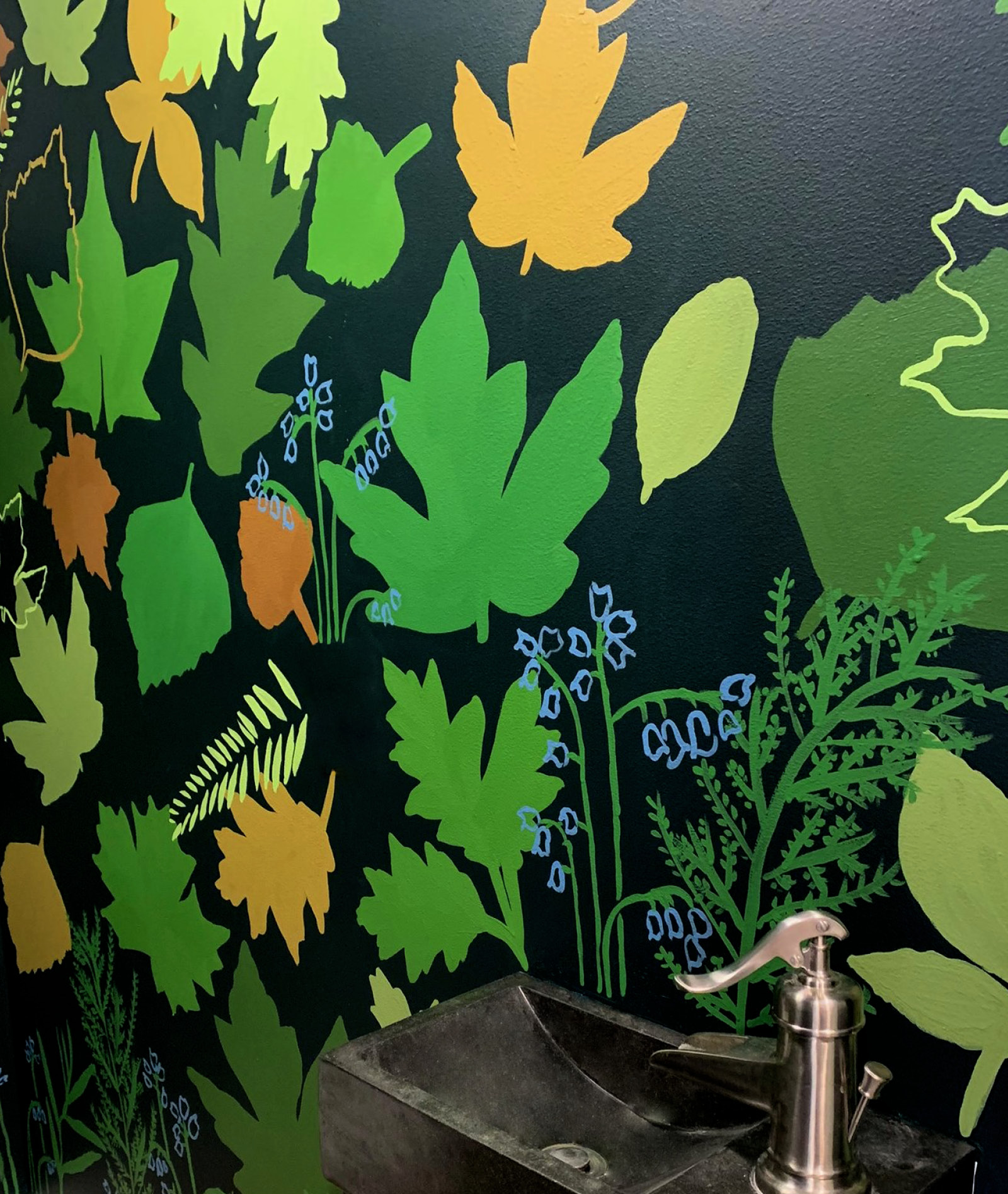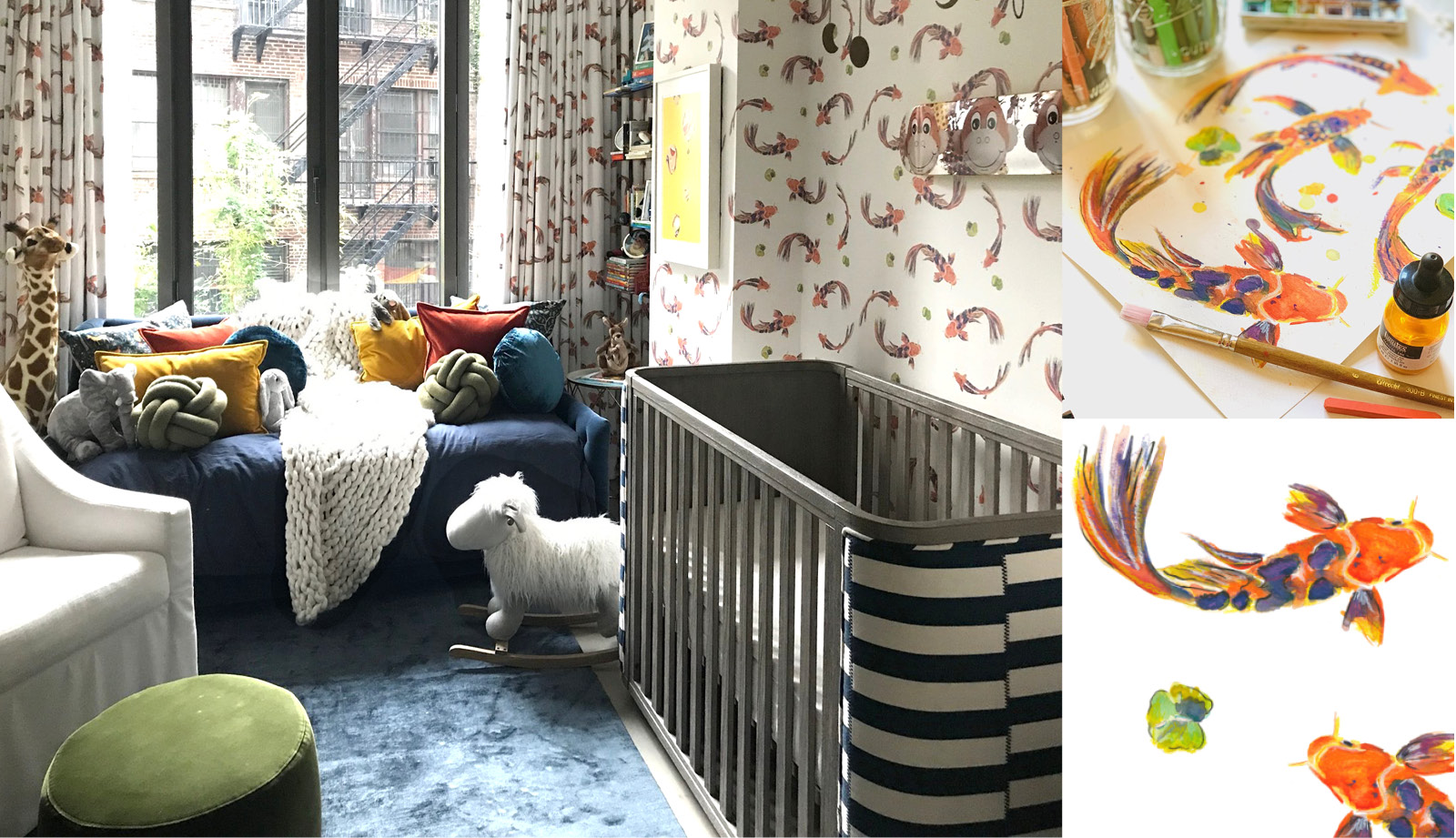
It’s my experience that if your passion for interiors runs deep, your passion for fashion does too. That certainly hits home for me and for a favorite artist and friend of mine Ali Reboul.
Diane Von Furstenberg, Alice + Olivia, Jill Stuart, and the iconic Oscar de la Renta. Ali has had her hand in all of those coveted labels. Educated at the finest that creative academia provides (she attended both RISD and FIT), Ali launched her career in the fashion world. She crafted her artistry to create patterns for garments that would canvas the bodies of the most stylish fashionistas.
Now her canvas is significantly larger. Ali is a print artist whose work comes alive on textiles, walls, and all things decorative. She taps into her clients for custom pieces that will capture their visual lifestyles. I know first-hand because Ali and I embarked on our own collaboration for my family’s 19th-century house in the Catskills (see above). The result was a delightful modernized rendition of the pennyroyal plant that grows near our home and is its namesake. Another recent collaboration with Ali is a bold and daring hand-painted powder room (see below).
Meet Ali.

Your product isn’t traditional wallpaper that you would buy in endless rolls from a warehouse that serves a design powerhouse. Tell me about its artful slant.
People tend to look at art as something that is two-dimensional and goes into a frame. My work can be two-dimensional, too, but it’s a super painting, if you will, that stretches across the entire wall. There is artwork everywhere, not just in one spot. When looking at traditional painting, people tend to think of it in a specific format, thinking about fundamentals such as balance and composition. When I imagine a textile or wallpaper, it’s a different process because of the repeat that provides so much more surface and opportunity to make a mark.
Color speaks to me, and I embrace the freedom to use it in my interiors. But not everyone feels the same. How do you push clients to use color in a world that often settles for beige?
I come with a lot of flexibility and can create a design that works with the colors that a client does love. If green is what they want, I can weave that into my pattern statement. We’ve all been trapped at one point or another with that feeling of “It’s restful, elegant, and beautiful in beige or ivory.” That look makes people feel safe. But I always push clients to introduce something personal, such as a signature color that reminds them of their travels or a flower that is meaningful to them. Otherwise my work may be beautiful and interesting, but it will never really be a part of them.

What trends do you see in client requests as you collaborate with them on murals and patterns?
Nature. People love nature, and they want to bring it indoors. Nature is calming, and it soothes. It’s always a fun challenge to hear what parts of nature attract someone. It’s difficult for people to imagine what they can’t see. There is so much trust involved, but we have to start somewhere. I ask that a client comes to me with something that I can build on. All I have to do is get people to talk about what they love. That’s when those personal details slip into conversation, such as a certain shade of blue or the vacation that’s provided the happiest memories or a collected piece that they treasure. When I get them talking, that’s when the nuances of what they love pop forward. Everyone needs to come to me with their “trinket.” Then I need to take that trinket and make it into something special.
You create in a world that revolves around personalization. How do you convince your client when they may have difficultly imagining what it will become?
We come from a time when everything is picture-perfect. The Instagram Effect. The sky’s the limit right now. You can customize your phone. You can customize your bag. But when it comes to space, people have a difficult time with personalization. They tend to get nervous, and their uncertainty shifts them into that safe place that I referred to earlier. It’s good to have that base, but it’s important to make your home a reflection of YOU—not a reflection of what will appeal to others down the road. That is the role of professional creatives. Artists and designers must educate clients to stretch their imaginations. It’s like a white shirt and jeans. We all know this has the potential for a great look, but the foundation requires personalization—a great necklace, a scarf that is tied in a chic way. Make everything YOU.

How do you edit an idea?
I think of creativity somewhat like speed dating. You want to date your home and ask a whole lot of questions. When you start thinking about a trend, ask yourself why you like it. Can you confidently say that you want to bring it home? Can you imagine it being with you all of the time? Develop a set of criteria before you move forward with a trend. Like dating, when we see something that we find attractive, we want it. It brings us joy. Developing a set of criteria will save you hassles and headaches later. Understand that just because you find joy in something trendy doesn’t mean that it will work for you. Sometimes things are meant to be seen only and not necessarily lived with.
How and why does something become a classic?
It has to do with time and versatility. If something can be lived with for years and doesn’t change with the trends, then it falls into the “classic” category. In the fashion world, that means garments that can be worn over and over for many seasons and many years. Chances are the garment will wear out before the style does. In the home, it’s an environment that you can live with for a long time, maybe forever. Classics are the perfect foundation for a slight update. Think about stripes, for instance. They are timeless and orderly and don’t change. But there are ways to uplift them—a new palette, a less strict line. Classics are chameleons that can adapt.
The worlds of fashion and home often overlap. The schedule used to start with fashion and then home followed. Does that remain true?
We used to assign everything to a box, and attitudes were far stricter. This is for fashion, and this is for home. I jumped into the interiors world and realized that it all translates the same. It becomes more about “What is your STYLE?” as opposed to what you love to wear or what you love to live with. When a person develops a style, they are capable of making decisions in both arenas. We have to look at fashion and home as the same thing now because as you make selections for both, you are creating your own personal brand. And that should be fun. We tend to feel pressure when making decisions for our homes, because we think that our home should be the star. But really, a home should be joyful and enhance the real star—and that is YOU.
Explore Ali’s designs and the ways she makes you the star.

